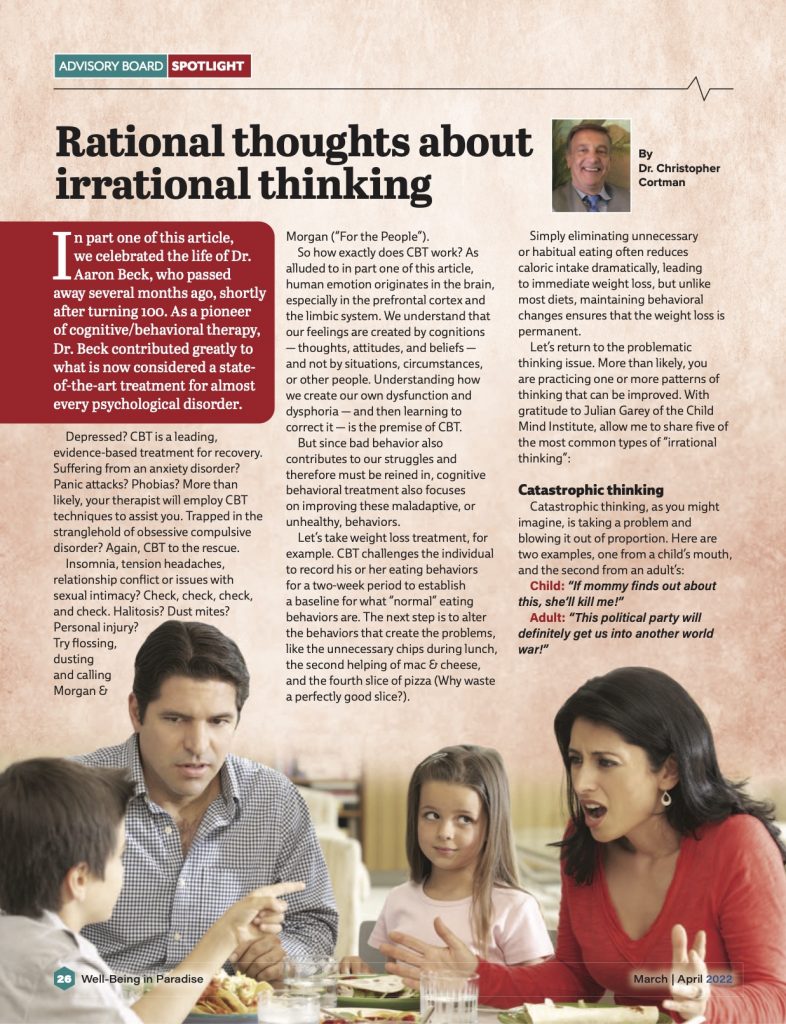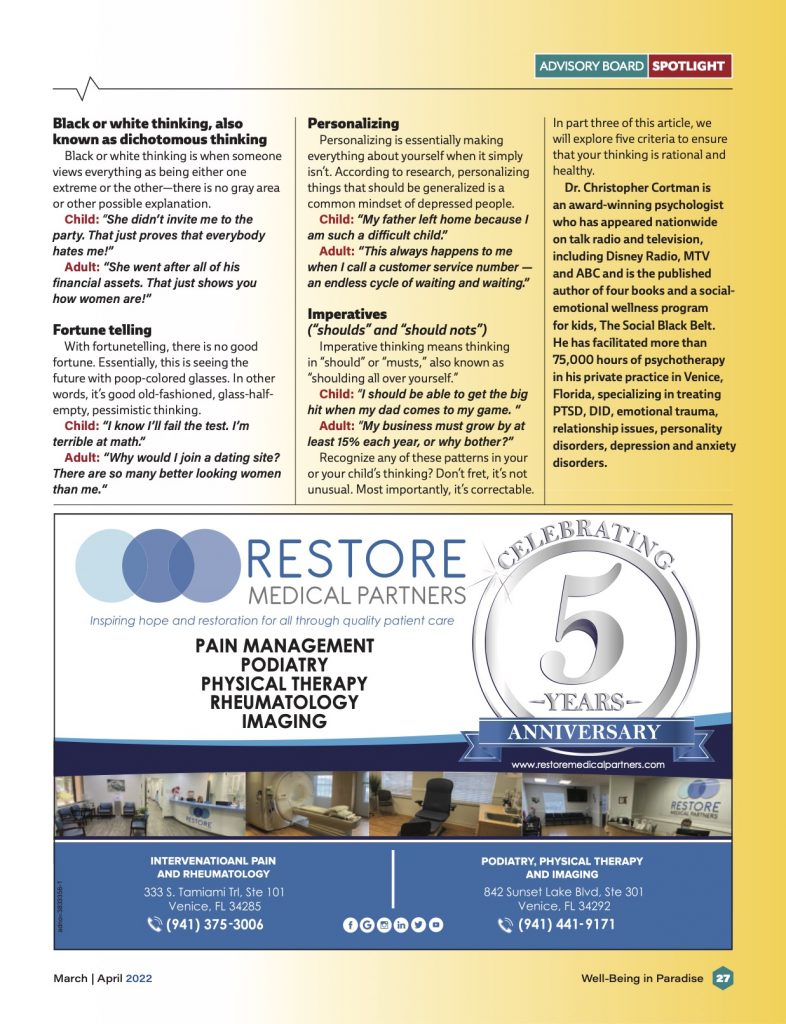Article written for the Venice Gondolier’s Well Being in Paradise Magazine | March/April 2022
In part one of this article, we celebrated the life of Dr. Aaron Beck, who passed away several months ago, shortly after turning 100. As a pioneer of cognitive/behavioral therapy (CBT), Dr. Beck contributed greatly to what is now considered a state-of-the-art treatment for almost every psychological disorder.
Depressed? CBT is a leading, evidence-based treatment for recovery. Suffering from an anxiety disorder? Panic attacks? Phobias? More than likely, your therapist will employ CBT techniques to assist you. Trapped in the stranglehold of Obsessive Compulsive Disorder (OCD)? Again, CBT to the rescue. Insomnia, tension headaches, relationship conflict, or issues with sexual intimacy? Check, check, check, and check. Halitosis? Dust mites? Personal injury? Try flossing, dusting, and Morgan & Morgan (“For the People”).
So how exactly does CBT work? As alluded to in part one of this article, human emotion originates in the brain, especially in the prefrontal cortex and the limbic system. We understand that our feelings are created by cognitions—thoughts, attitudes, and beliefs—and not by situations, circumstances, or other people. Understanding how we create our own dysfunction and dysphoria—and then learning to correct it—is the premise of CBT.
But since bad behavior also contributes to our struggles and therefore must be reigned in, cognitive behavioral treatment also focuses on improving these maladaptive, or unhealthy, behaviors. Let’s take weight loss treatment, for example. CBT challenges the individual to record his or her eating behaviors for a two-week period to establish a baseline for what “normal” eating behaviors are. The next step is to alter the behaviors that create the problems, like the unnecessary chips during lunch, the second helping of mac & cheese, and the fourth slice of pizza (Why waste a perfectly good slice?). Simply eliminating unnecessary or habitual eating often reduces caloric intake dramatically, leading to immediate weight loss, but unlike most diets, maintaining behavioral changes ensures that the weight loss is permanent.
Let’s return to the problematic thinking issue. More than likely, you are practicing one or more patterns of thinking that can be improved. With gratitude to Julian Garey of the Child Mind Institute, allow me to share five of the most common types of “irrational thinking”:
1) Catastrophic Thinking
2) Black or White Thinking, also known as Dichotomous Thinking
3) Fortune Telling
4) Personalizing
5) Imperatives (“Shoulds” and “Should Nots”)
Catastrophic Thinking, as you might imagine, is taking a problem and blowing it out of proportion. Here are two examples, one from a child’s mouth, and the second from an adult’s:
Child: “If mommy finds out about this, she’ll kill me!”
Adult: “This political party will definitely get us into another world war!”
Black or White Thinking is when someone views everything as being either one extreme or the other—there is no gray area or other possible explanation.
Child: “She didn’t invite me to the party. That just proves that everybody hates me!”
Adult: “She went after all of his financial assets. That just shows you how women are!”
With Fortune telling, there is no good fortune. Essentially, this is seeing the future with poop-colored glasses. In other words, it’s good old-fashioned, glass-half-empty, pessimistic thinking.
Child: “I know I’ll fail it. I’m terrible at math.”
Adult: “Why would I join a dating site? There are so many better looking women than me.“
Personalizing is essentially making everything about yourself when it simply isn’t. According to research, personalizing things that should be generalized is a common mindset of depressed people.
Child: “My father left home because I am such a difficult child.”
Adult: “This always happens to me when I call a customer service number—an endless cycle of waiting and waiting.“
Imperative Thinking means thinking in “should” or “musts,” also known as “shoulding all over yourself.”
Child: “I should be able to get the big hit when my dad comes to my game. “
Adult: “My business must grow by at least 15% each year, or why bother?”
Recognize any of these patterns in your or your child’s thinking? Don’t fret, it’s not unusual. Most importantly, it’s correctable. In part three of this article, we will explore five criteria to ensure that your thinking is rational and healthy.


